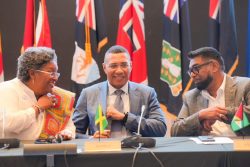The struggle of the working class and the organised activity of the trade union movement have substantially determined the course of Guyana’s history. While Guyana was not unique, it led the way with the formation in 1922 by Hubert Nathaniel Critchlow of the BGLU (British Guiana Labour Union), the first trade union registered in the British Empire in 1922.
Several trade unions were formed subsequently, among them the TWU (Transport Workers Union). Registered in 1938, it had become by the mid-1940s one of the largest and most militant. The Teare Strike by the TWU in 1947 was called to protest the suspension of two workers for trade union activity. It lasted for two weeks, crippled the movement of people and goods in the country and succeeded in its objective of obtaining a commitment that the contract of Colonel Teare, who was the authoritarian British General Manager of the Transport and Harbours Department, would not be renewed after it expired, an unheard of concession at that time.
crippled the movement of people and goods in the country and succeeded in its objective of obtaining a commitment that the contract of Colonel Teare, who was the authoritarian British General Manager of the Transport and Harbours Department, would not be renewed after it expired, an unheard of concession at that time.
This strike most likely energised sugar workers and the GIWU (Guyana Industrial Workers Union), the predecessor to GAWU, into renewed struggle the following year, leading to the tragic loss of life at Enmore by the Martyrs.
The GIWU was established in 1946 and was formed to represent sugar workers, who had lost confidence in the officially recognised Manpower Citizens Association (MPCA). The epic thirty-year trade union struggle of GIWU/GAWU to secure representation of sugar workers formed the sub stratum of larger political events, which dominated critical moments in the story of post-war Guyana. So did the reactionary role of the trade union movement in the early 1960s and its subsequent loss of militancy due to political domination.
In 1974, Cde Cheddi Jagan sent me to “help out” GAWU (the Guyana Agricultural and General Workers Union). He organized a meeting between Richard Ishmael, the president of the MPCA, and GAWU, whose delegation I led, to offer support for an ongoing strike of sugar workers. As soon as the offer was made the strike was settled.
Shortly after he again asked me to lead a GAWU delegation to negotiate with Richard Ishmael and his colleagues in the MPCA a merger between the two unions. No member of the delegation, which included Harry Lall, the president of the union, but who was asked to defer to me as spokesperson, (he had been known to be in close touch with the PNC which he joined the following year) believed such a bold initiative would succeed. As expected, the talks reached an impasse at the second meeting.
This early experience in my political life, opened a window for me. Richard Ishmael, a leading trade unionist, had been bitterly opposed to the PPP Government in the early 1960s, and had been widely accused of collusion with British and American security agencies to remove the PPP Government in 1964. To be asked to negotiate a merger between GAWU, backed by the PPP, and the MPCA, led by Richard Ishmael, demonstrated to me the overarching vision of Cheddi Jagan, his deep understanding of building alliances for a united working class and his capacity to set aside personal differences in the pursuit of his larger goals for Guyana. For Cheddi Jagan, the interests of workers surpassed every other consideration. He believed that the divisions between the two unions was having a deleterious impact on their struggle, as indeed it was, and notwithstanding the bitter hostility between the PPP and Ishmael in the recent past, he put the interests of workers ahead of personal considerations. We saw Cheddi Jagan rising above the personal before that time and we were to see it again and again. It took the PPP more than 40 years after initial efforts in 1953, and the loss of office twice, to establish the legal right for workers to have a union of their choice to represent them. The passage of the Trade Union Recognition Act, the Termination of Employment and Severance Pay Act, both in 1997, and the Occupational Safety and Health Act (No. 2) in 2007 and others which have entrenched workers’ rights, had to await the advent of the PPP/C Government in 1992.
The PPP’s ideological and political commitments make it an objective ally of the trade union movement and the GPSU, despite a history of mutual suspicion. The time has come to boldly change course, to leave the past behind and end the more than a decade-and-a- half long standoff between the government and the GPSU. The first step should be to invoke the mechanisms of negotiation, conciliation and arbitration as provided for by law to resolve the current dispute. The difficult but not impossible task can then commence by discussion and negotiation to resolve other long outstanding differences with the GPSU, many of which are eminently capable of creative resolution, but have been allowed by successive PPP/C Governments to fester and poison relations.
Then let the success with the GPSU lead to renewed efforts to heal the rift in the trade union movement and be a template for a general political solution as a New Year gift to the nation by our political parties.






